MARIANI’SVirtual
Gourmet
April 13,
2013
NEWSLETTER
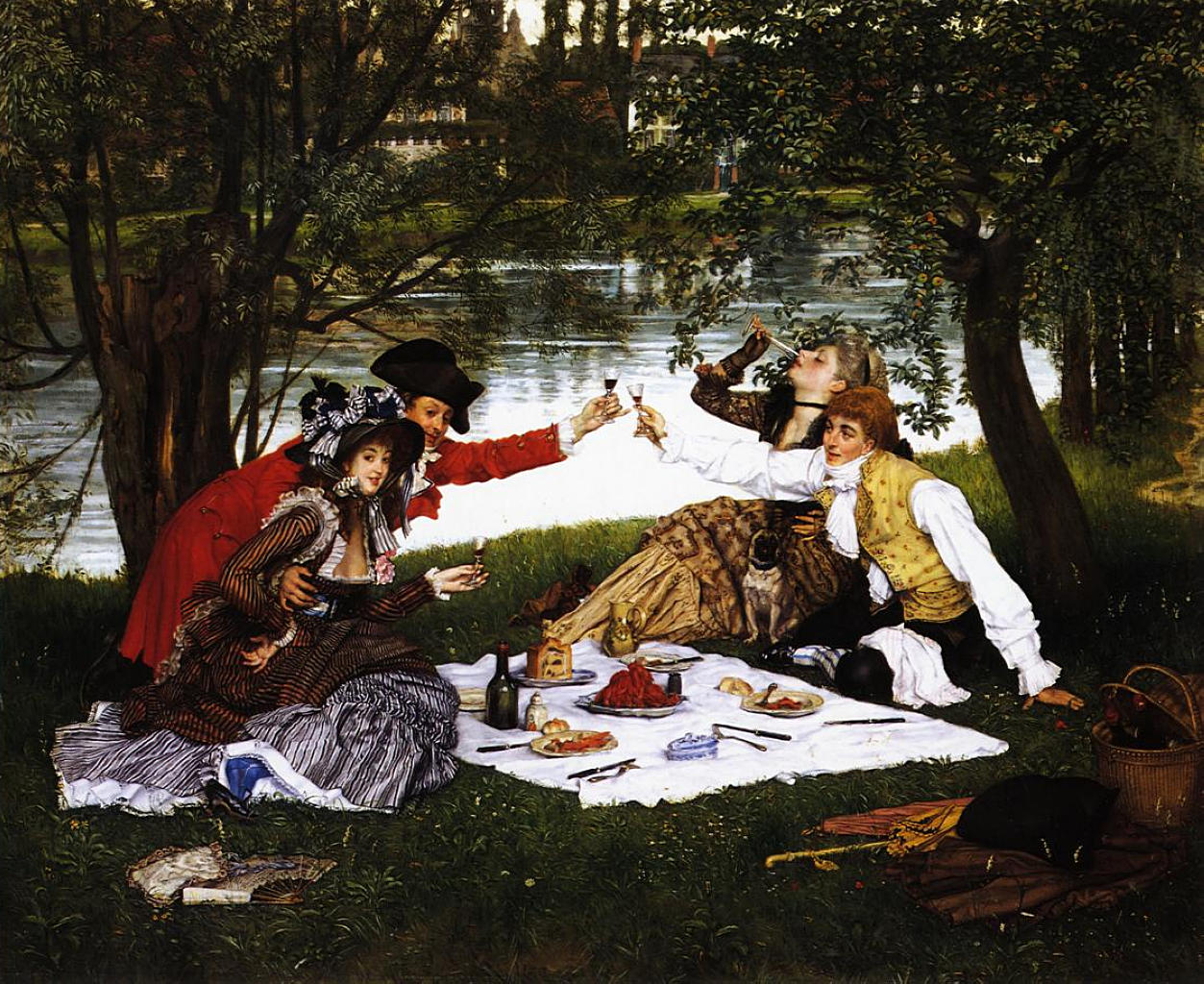
NEW ORLEANS, PART TWO
By John Mariani
NEW YORK CORNER
Arlington Club
by John Mariani
Notes
from the Brewery
by Mort Hochstein
❖❖❖
By John Mariani
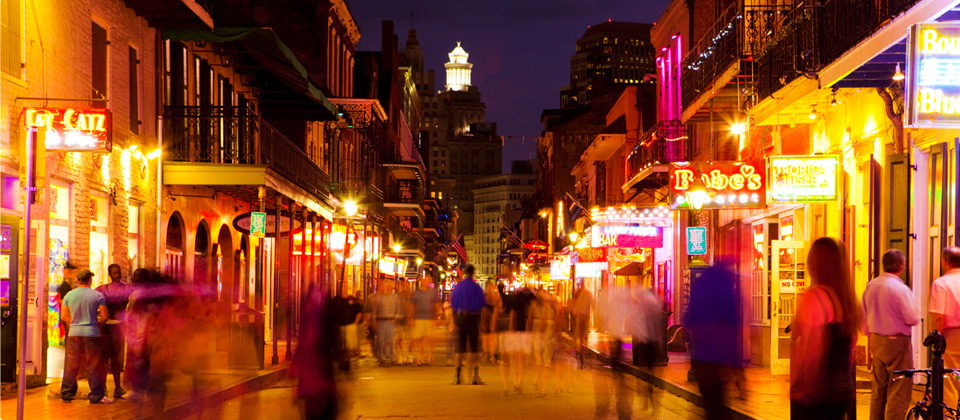
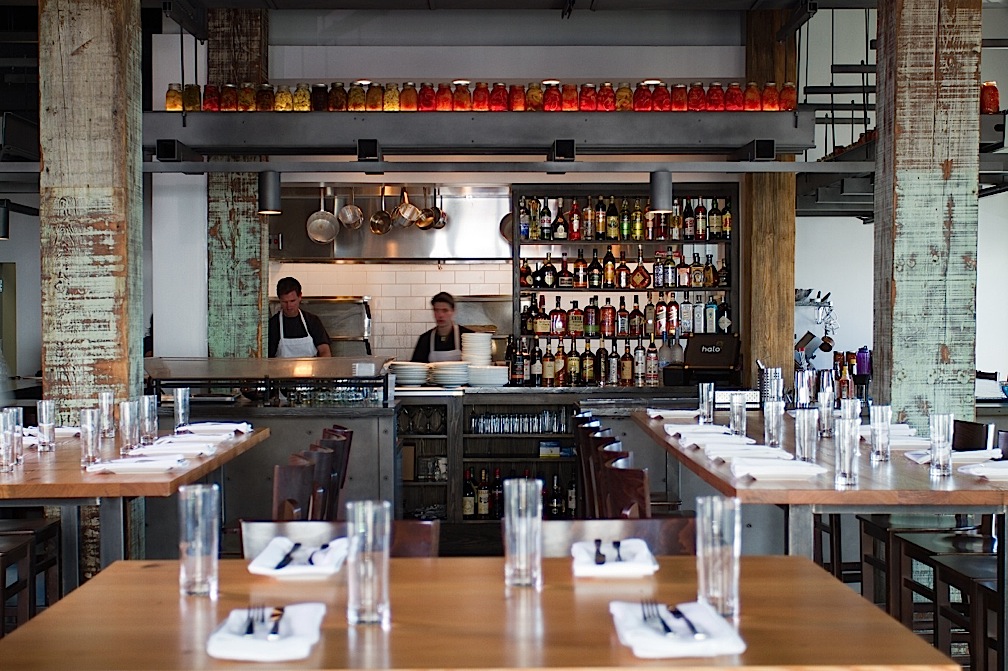 mariza
mariza2900 Chartres Street
504-598-5700
marizaneworleans.com
The most exciting new restaurant in New Orleans, located just next to the French Quarter in a gentrifying neighborhood called Bywater, is Mariza, where Chef Ian Schnoebelen and Laurie Casebonne have fitted impeccably into a new apartment building carved out of an old rice plant by developers TJ Iarocci and Sean Cummings, retaining as much of the industrial look of concrete and cement walls, tall ceilings, and old woodwork as possible. The dining room echoes that design both in the bar and dining room and smaller eating room off to the side. However, way too many tables and chairs are counter height, more appropriate to a wine bar than
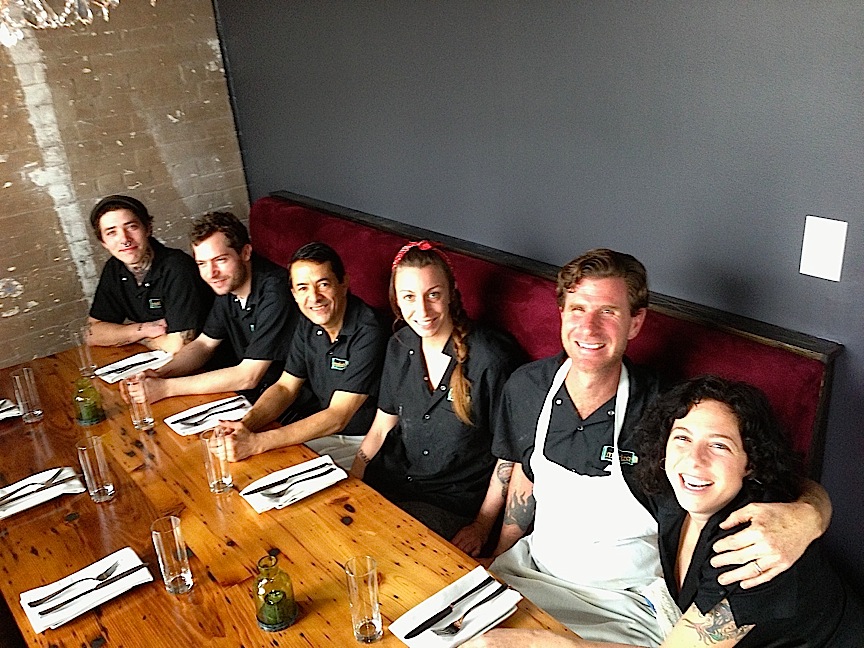 a serious restaurant, and I
hope someone just takes a handsaw to the legs and
brings them down to dining level.
a serious restaurant, and I
hope someone just takes a handsaw to the legs and
brings them down to dining level.Schnoebelen and his wife Laurie (right, seated at the right) fell in love with Venetian seafood, and the Crescent City is not unlike Venice in its curving waterways and access to the sea. There's a raw bar here, and you see homage to Venetian cuisine in dishes like squid ink linguine with crab, shrimp and mussels and seafood carpaccios, and since there is now a pizzeria on every block of Venice, there's no harm in serving a couple as good as those at Mariza.
The pasta dishes may be gussied up with slices of bread (starch on starch?) but they are truly delicious, not least the duck ragôut [sic]
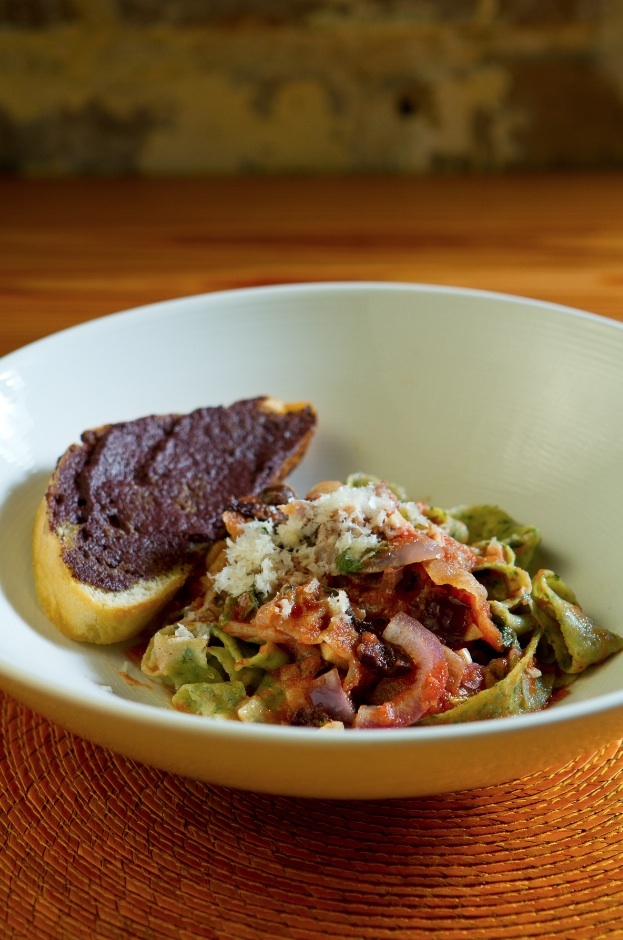 pappardelle
with smoked duck breast and liver mousse, and the
potato gnocchi with kale and ricotta.
pappardelle
with smoked duck breast and liver mousse, and the
potato gnocchi with kale and ricotta. Goat's milk ricotta is also added to the standout bruschetta with kale and balsamico, and the pepperoni soup with salame and Gorgonzola is easily one of my favorite dishes of the year. A simply grilled fish with a fennel salad and lemon vinaigrette could not have been more expertly cooked. For dessert go with the chocolate terrine with sea salt and candied blood orange.
The wine list might be a bit larger--just 40 selections now--but they are well priced, with plenty of bottlings under $40.
Mariza adds measurably to a developing neighborhood and serves as a beacon for what's to follow.
Mariza is open for dinner Tues. Sat.
dominique's ON MAGAZINE
4213 Magazine Street
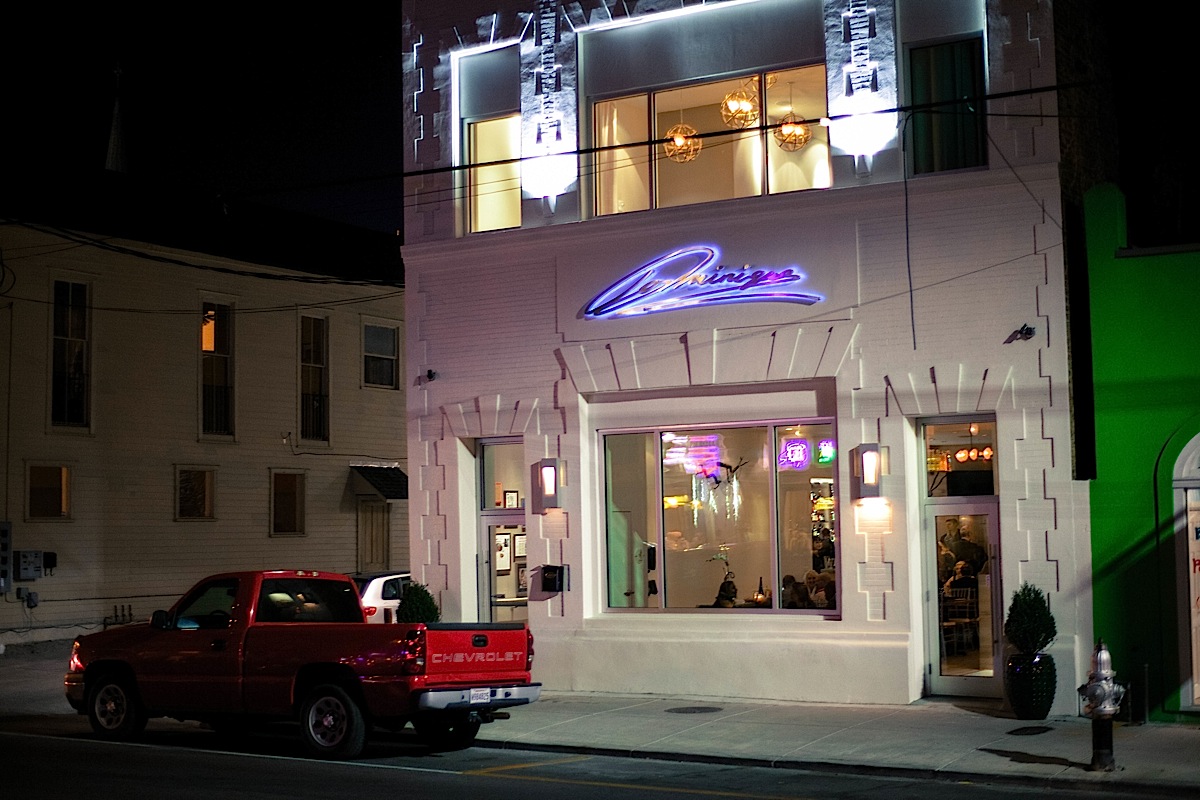
504-891-9282
dominiquesonmag.com
The overnight demise in 2012 after only a few months in operation of the first restaurant by this name caused many to wonder just what had happened to a place that seemed to do booming business. Whatever the cause, Dominique Macquet, the Mauritius-born chef who first lent his name to a restaurant in New Orleans a decade ago and fled to Houston after Hurricane Katrina, has returned to the river city he loves and, with new investors, opened a larger, 200-seat version of Dominique's in an old fire station on Magazine Street. It's been a smash hit since opening this spring, and although it's a pricey cab ride out here, tourists have found it well worth the time and money.
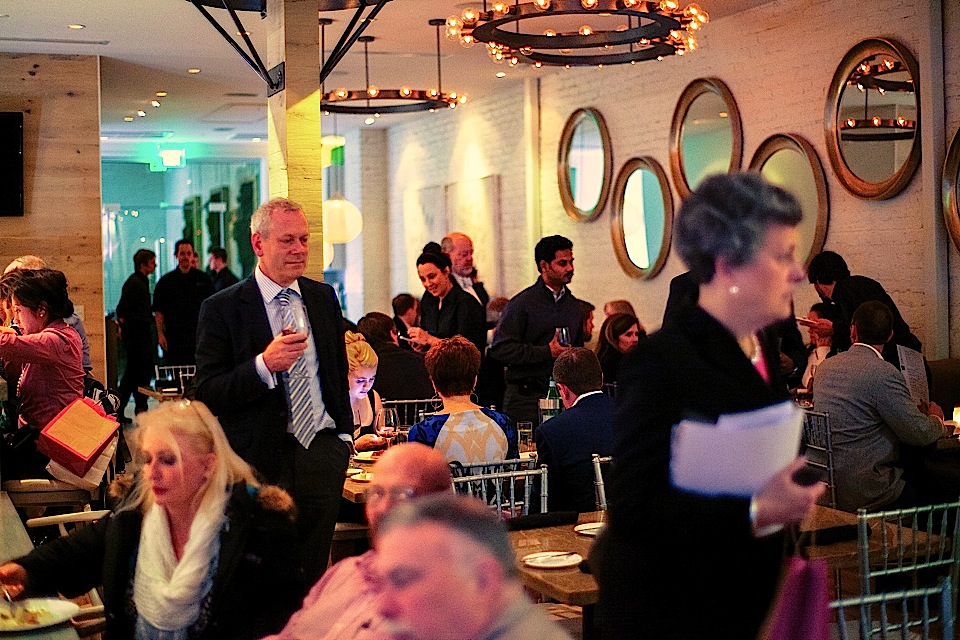 Except for the
high ceilings, there's not much more to remind you this
was once a 1909 fire station. Indeed, it's just about
the most modern, classiest place to open in town in
years. Excellent lighting and soft colors, mixed with
wall art and, to the rear, potted plants in the patio
section, make it very. very comfortable, and the staff
is well trained to attend to the rush that begins by
seven o'clock.
Except for the
high ceilings, there's not much more to remind you this
was once a 1909 fire station. Indeed, it's just about
the most modern, classiest place to open in town in
years. Excellent lighting and soft colors, mixed with
wall art and, to the rear, potted plants in the patio
section, make it very. very comfortable, and the staff
is well trained to attend to the rush that begins by
seven o'clock.The 180-label wine list is substantial and globally mixed. Cocktails--always a requisite in New Orleans--are well wrought.
Macquet's handling of tropical spicing has always been key to his cuisine, and it's good to see he has brought back many of the dishes that were hits on his former menus. Start off with sautéed sweetbreads with pommes puree and a dash of chimichurri--yes, it is an appetizer but the portion is just right. Seared shrimp remoulade--a dish everyone in town does--is given life here with the nuances of crispy kohlrabi and oven-dried
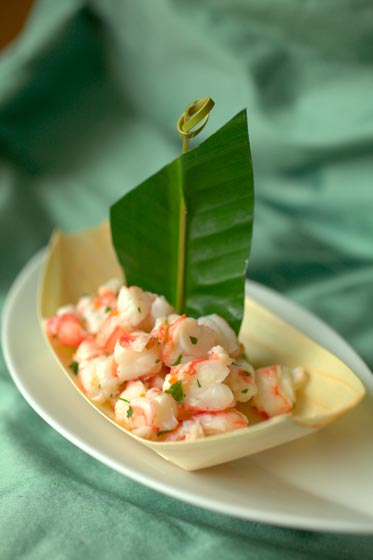 tomatoes in the
sauce, with a hint of mint oil in the background.
The lobster and celeriac salad with fennel, basil
aïoli and lime oil is distinctively Macquet, as is
the entree of seared wild conch with peas and rice,
whitewater clams nage,
coconut-tamarind chutney and green mango relish--a dish
you only wish
were made this well anywhere in the Caribbean.
tomatoes in the
sauce, with a hint of mint oil in the background.
The lobster and celeriac salad with fennel, basil
aïoli and lime oil is distinctively Macquet, as is
the entree of seared wild conch with peas and rice,
whitewater clams nage,
coconut-tamarind chutney and green mango relish--a dish
you only wish
were made this well anywhere in the Caribbean. Among meat dishes the grilled lamb t-bone is amazing, with basil-mint pommes puree, cracklings and a hot harissa sauce. Grilled wagyu-style beef coulette (albeit from Nebraska) is a good choice, especially at only $26. It's stuffed with Creole cream cheese and accompanied by cream peas, watercress, carrot flan and red wine jus. That same beef goes into Macquet's spaghetti and meatballs with over-dried tomatoes, veal jus and shaved piave cheese--good and substantial and a dish no one will allow him to take off the menu.
There's no decrease in fine taste with dessert here, led by goat's cheese cake and honey, and a terrific almond nougatine.
I'm glad Dominique's is back, bigger and better than ever, and trust he will be so for a long long time.
Dominique's is open for dinner Tues.-Sat. and for Sunday brunch. Prices for starters run $8-$10, entrees $22-$26.
 SoBou
SoBou
310 Chartres Street
504-552-4095
For three decades,
restaurants run by the Brennan family, including Mr.
B’s Bistro, The Bourbon House, Palace Café, and
others, have regularly made Esquire’s
list. This year, sisters Ti and Lally Brennan, who
also run the revered Commander’s Palace and
Café Adelaide, have returned to the
post-Katrina French Quarter to open SoBou (South of
Bourbon Street), where Chef Juan Carlos Gonzalez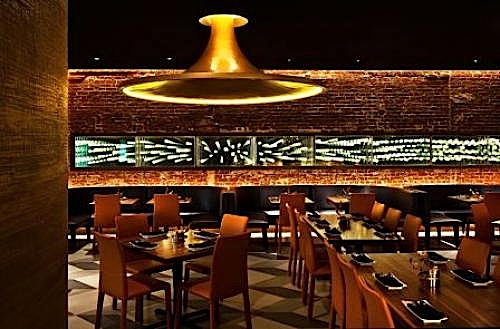 brings bar
food to a taste level I just have never encountered before,
like jarred blue crab mousse with ghost pepper caviar;
duck “debris” and butternut beignets napped with a
foie gras fondue and chicory ganache; Cajun andouille
sausage and tasso ham meatballs; and cherries jubilee
bread pudding laced with brandy. Add to all
that, one great bar with one smart, sassy bartender,
Abigail Gullo, serving rigorously classic and brashly
innovative cocktails, and you have what the Brennans
call a “Modern Creole Saloon.” Oh, hell, let Ti tell
you about it:
brings bar
food to a taste level I just have never encountered before,
like jarred blue crab mousse with ghost pepper caviar;
duck “debris” and butternut beignets napped with a
foie gras fondue and chicory ganache; Cajun andouille
sausage and tasso ham meatballs; and cherries jubilee
bread pudding laced with brandy. Add to all
that, one great bar with one smart, sassy bartender,
Abigail Gullo, serving rigorously classic and brashly
innovative cocktails, and you have what the Brennans
call a “Modern Creole Saloon.” Oh, hell, let Ti tell
you about it:
“Katrina is something we tried to put
behind us as quickly as possible and not dwell on it.
But you do not forget times like that. Katrina did 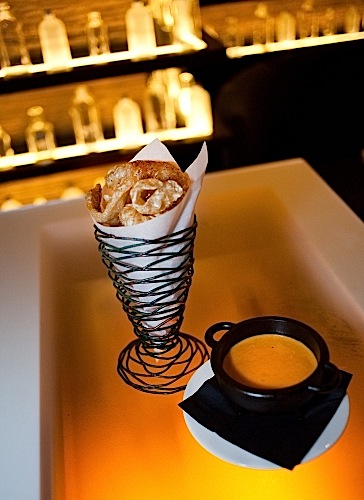 make us want to come back
stronger and say, `let’s show the world that, contrary
to popular myth, we are roaring back to life.’
make us want to come back
stronger and say, `let’s show the world that, contrary
to popular myth, we are roaring back to life.’
“It took us two years to build SoBou.
When you open up walls and floors in the French
Quarter, huh, you find interesting things. There was
one wall where a worker touched a pipe that literally
crumbled in his bare hand.
“With SoBou we wanted to re-capture the
atmosphere of the Old Absinthe House, the drinks place
where we Brennans began in 1943, but with a modern
edge. Y’know, Louis Armstrong and Ella Fitzgerald are
singing, there are only people you love at the bar,
and there are no hangovers at the saloon in the sky?
So for us, while the food will always be center stage,
the cocktails are stage right and the wine is stage
left.
“We serve Louisiana street food,
inspired small plates, along with Juan Carlos’s Puerto
Rican street food, but `Creolized’ for us. Around here
we all remember going fishing and stopping at a gas
station where the guy had two ice-chests behind the
counter. One with bait and one with the best boudin
you ever ate. I don’t know how we didn’t all die.
Well, I could go on and on, but I’ll spare you, and I
need to go celebrate anyway!”
SoBou is open for breakfast,
lunch and dinner daily. Small dishes $7-$12,
large dishes $17-$20.
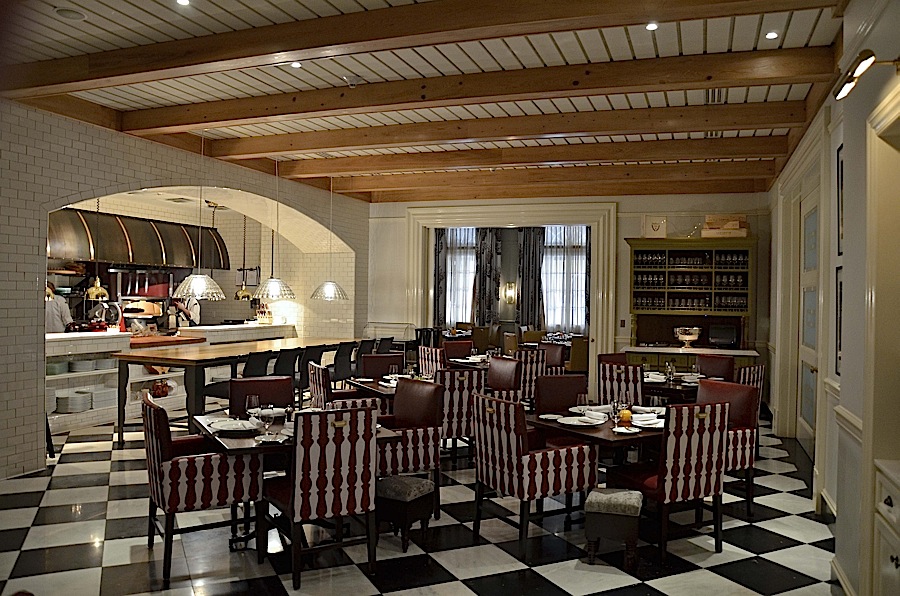
777 Bienville Street
504-553-2277
www.revolutionnola.com
The partnering of
The Royal Sonesta Hotel New Orleans with two of
America's most notable chefs, John Folse and Rick
Tramonto, was cause to rejoice in New Orleans for
months before their restaurant R'evolution opened last
June. While Folse is one of the true authorities
on Creole and Cajun cuisine and a restaurateur, food
producer, and author, while Tramonto set sail on his
own culinary career as one of Chicago's most
innovative chefs, at Tru. The combination, together
with loads of money poured into the huge premises,
shows that grandeur is not dead and ambition on a
large scale still flourishes.
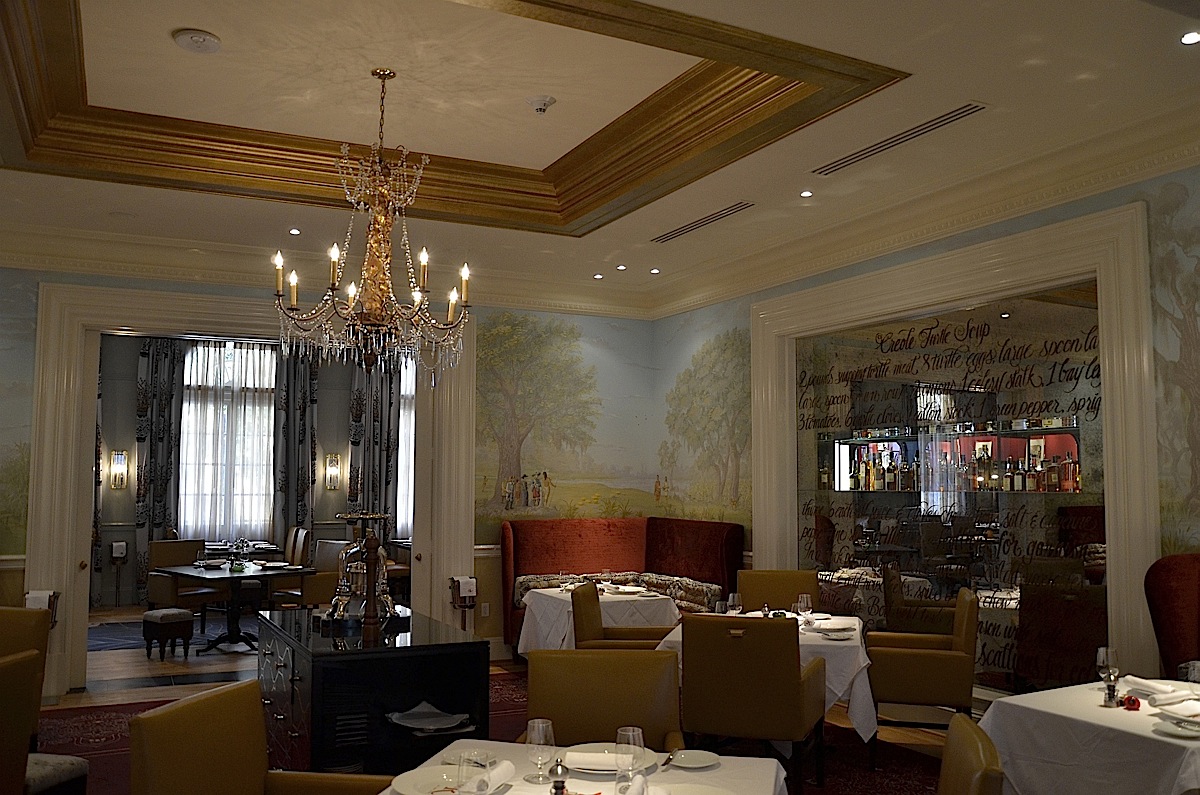 R'evolution is
a series of rooms of different styles, from a dark
traditional-looking oak bar to a wide-open,
brightly lit kitchen Market dining area (above), flanked
with dining rooms like the Storyville Parlor (left) that might
easily fit into the milieu of mid-19th century
Louisiana. There are slate floors, slate
floors, gas lanterns, and cypress
ceilings. It might be argued that this mix of
the historic with the traditional and the thoroughly
modern makes for a disjunction of styles, so guests
will have to figure out which ambiance they're in the
mood for.
R'evolution is
a series of rooms of different styles, from a dark
traditional-looking oak bar to a wide-open,
brightly lit kitchen Market dining area (above), flanked
with dining rooms like the Storyville Parlor (left) that might
easily fit into the milieu of mid-19th century
Louisiana. There are slate floors, slate
floors, gas lanterns, and cypress
ceilings. It might be argued that this mix of
the historic with the traditional and the thoroughly
modern makes for a disjunction of styles, so guests
will have to figure out which ambiance they're in the
mood for.
The menu is equally large--scores
and scores of dishes, from soups to sides, which, even
with two master chefs overseeing things, leaves
enormous room for error where consistency is needed to
make every dish right. And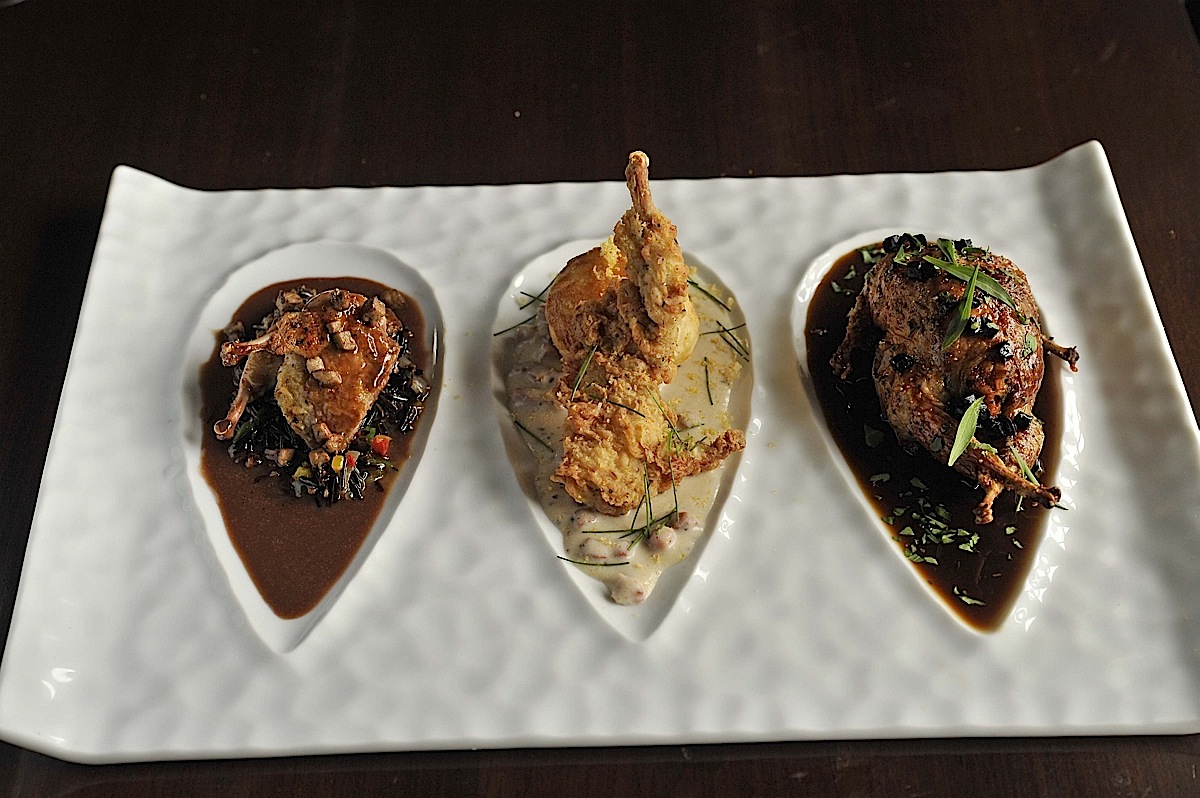 not every one
I tasted was. But there is more than enough on
this menu to please everyone, starting with
espresso-crusted venison carpaccio with black walnuts,
shaved dark chocolate, and dried fruit There's also a
lot to love about the beer-battered crab beignets with
four rémoulades. All the steaks and chop
items--ten of them, with eight sauces and 8
toppings--are dependable choices, and they are
rightfully proud of their Triptych of Kurobuta pork, which
presents crispy belly, smoked tail, and crispy ear.
not every one
I tasted was. But there is more than enough on
this menu to please everyone, starting with
espresso-crusted venison carpaccio with black walnuts,
shaved dark chocolate, and dried fruit There's also a
lot to love about the beer-battered crab beignets with
four rémoulades. All the steaks and chop
items--ten of them, with eight sauces and 8
toppings--are dependable choices, and they are
rightfully proud of their Triptych of Kurobuta pork, which
presents crispy belly, smoked tail, and crispy ear.
If you can't find your favorite
wine on the list here, it probably isn't imported. Ten
thousand bottles lie back there with a "special
emphasis on the seven nations that originally settled
Louisiana and make up the backbone of Creole cuisine."
R'evolution
is open for lunch Mon.-Fri. and for dinner nightly.
Appetizers run $10-$26, main courses $22-$48.
THE RELIGION OF Galatoire's
209 Bourbon Street
504-525-2021
www.galatoires.com
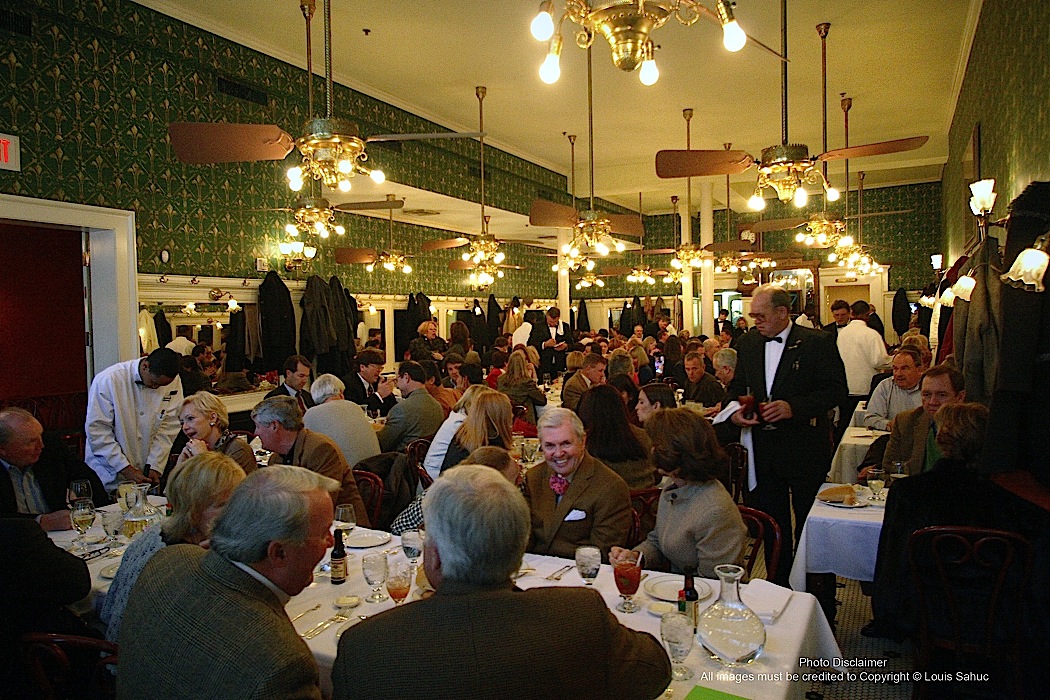 Frankly,
I
was not always a fan of Galatoire’s, for there was a
long period in its 108-year old history when the
food was merely mediocre.
Frankly,
I
was not always a fan of Galatoire’s, for there was a
long period in its 108-year old history when the
food was merely mediocre.
For years 32 members of the
Galatoire family had squabbled over their pieces of
the pie, and in 2009 an investor group led by John Georges
gained the majority interest in the restaurant, with
the family's participation reduced to only four
members and in a minority role. This
continuity of family participation was important to
the new investor group that included local businessmen
Todd Trosclair and Bill Kearney, who recognized that
that the venerable Galatoire’s could be a movable
feast through expansion. But first they had to improve
everything about the venerable restaurant without
seeming to change a thing.
Galatoire’s
décor and kitchen have been restored and the
cooking upgraded so that now it is among the best in
the Big Easy, as rendered by Chef Michael Sichel who
shows both care and respect for all those cooks who
preceded him for the past century, keeping the religion of
Galatoire’s alive.
They no longer have chipped ice in the water
glasses, but otherwise the restaurant is exactly the
same as ever, just so much better.
If asked where you’re going for
lunch in the French Quarter, say it the way they do in
New Orleans:
“GAL-a twahz.” Accent on the first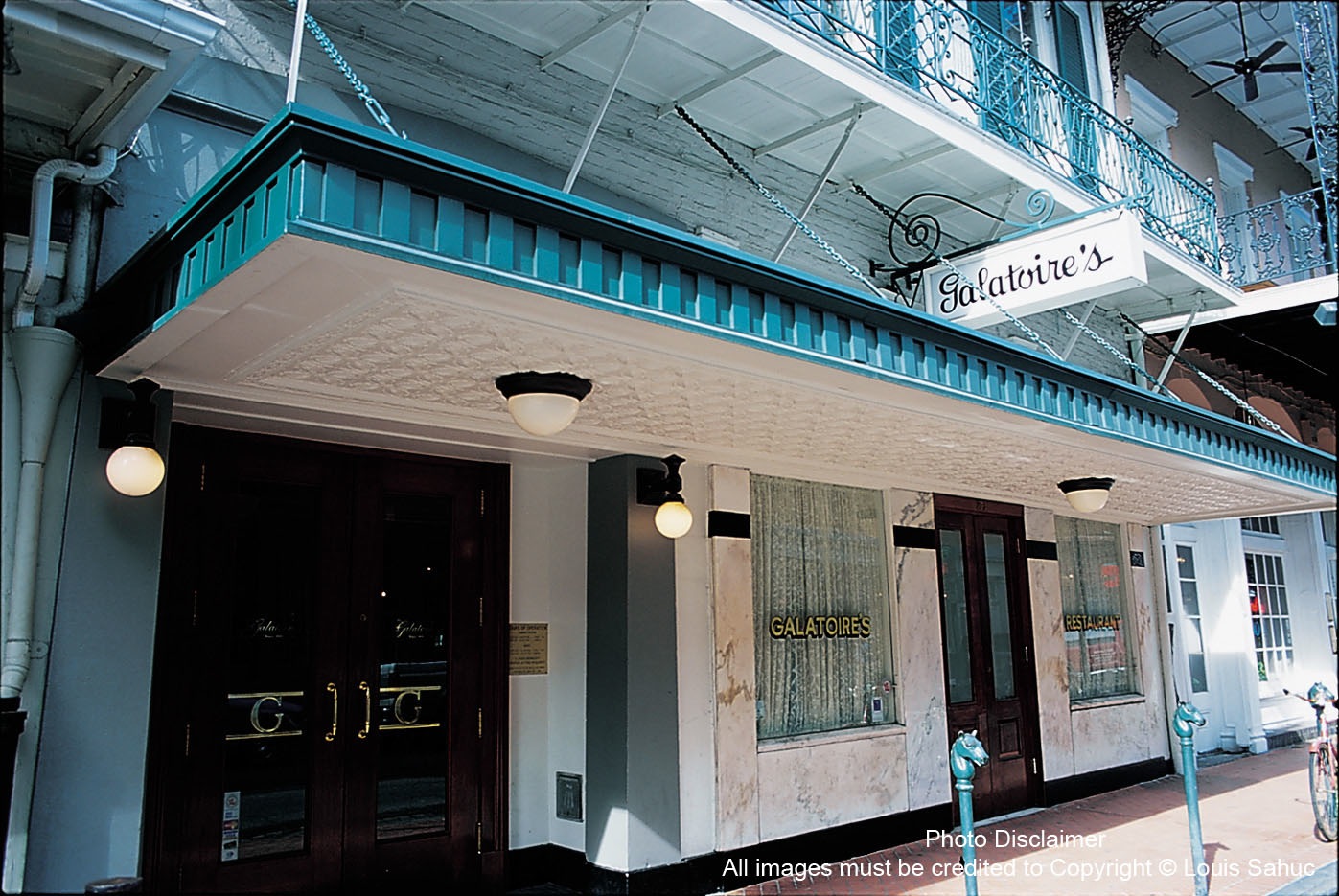 syllable then
slide into that big plummy finish. If you’re
speaking to a regular, he’ll answer back, “Excellent
choice! Say hello to Mike. He’s been my waiter for
twenty years.”
syllable then
slide into that big plummy finish. If you’re
speaking to a regular, he’ll answer back, “Excellent
choice! Say hello to Mike. He’s been my waiter for
twenty years.”
Galatoire’s is not as old as
Antoine’s (1840) nor does it have the culinary
reputation of Commander’s Palace, but it is a mystical
place in the hearts of New Orleanians whose families
have been coming here since French immigrant Jean
Galatoire opened up on Bourbon Street in 1905. Since then,
Friday lunch has been as requisite for New Orleanians
as Mass on Sunday and every bit as restorative.
Until Galatoire’s started taking
reservations a few years ago for the handsome upstairs
dining room, a well-behaved line of people would
stretch down the block to the corner of Iberville
Street to wait for a table downstairs, which is to
Galatoire’s what the Sistine Chapel is to the Vatican. Even in the
sauna-like heat of summer, the women dress to the
nines in pastels and men wear seersucker suits,
bowties, and the white Panama hats they bought at
Meyer the Hatter on Saint Charles Avenue. Some people
even hire stand-ins to get in line early in the
morning just after Bourbon Street has been washed
down.
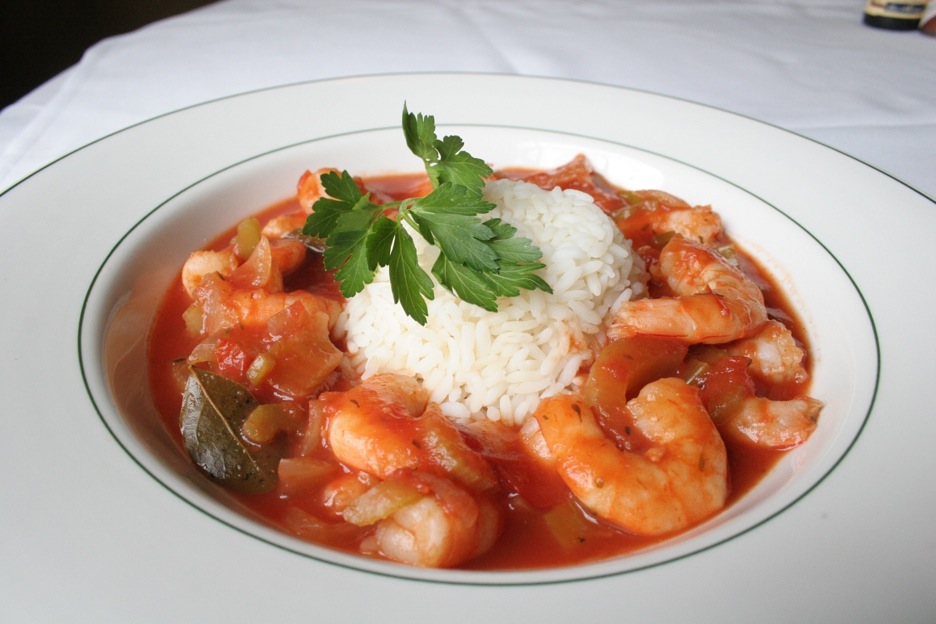 They
still
don’t take reservations for the downstairs dining
room, but, once inside the polished mahogany doors, if
your father and grandfather were regulars, you’ll ask
for your usual waiter, who arrives in a pressed tuxedo
and pleated shirt. He will acknowledge you with
cordial deference, not as a faux-pal. He will
take your cocktail order—everyone orders a cocktail on
Friday—then launch into the day’s specials, the ones
he himself approves of:
“Got some beautiful redfish in this morning,
and the soft shells came in big and fat. Fry ‘em up
with some Bearnaise sauce for ya.”
They
still
don’t take reservations for the downstairs dining
room, but, once inside the polished mahogany doors, if
your father and grandfather were regulars, you’ll ask
for your usual waiter, who arrives in a pressed tuxedo
and pleated shirt. He will acknowledge you with
cordial deference, not as a faux-pal. He will
take your cocktail order—everyone orders a cocktail on
Friday—then launch into the day’s specials, the ones
he himself approves of:
“Got some beautiful redfish in this morning,
and the soft shells came in big and fat. Fry ‘em up
with some Bearnaise sauce for ya.”
The busboy brings ice water and a
glass pitcher and a table for two still gets eight
pats of butter, refreshed after a while even if not
used. Hot
French bread comes next as you peruse the menu, which,
by and large, has not changed in decades and has never
strayed from its Creole traditions of classics like
gumbo, shrimp remoulade, oysters Rockefeller, and
chicken Bonne-Femme.
You look around the room and, with
the soft Louisiana sunlight seeping through the lace
window curtains, you see the familiar décor of
deep green walls imprinted with gold fleurs-de-lys,
cream-colored wainscoting, panels of mirrors, brass
sconces,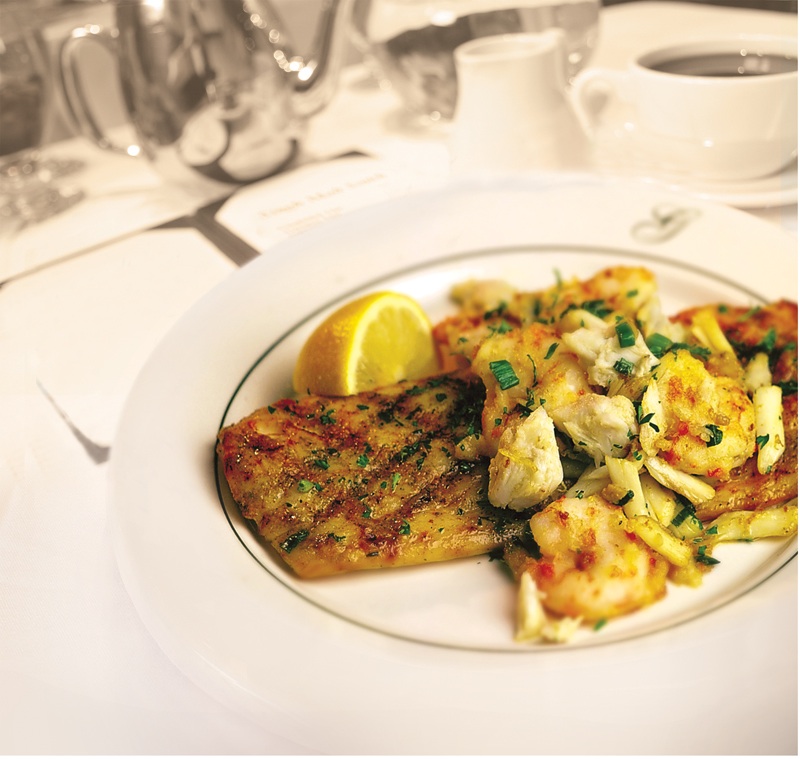 and ceiling fans doubling
as chandeliers, giving the room a timeless cast in
which the guests provide a booming joviality that is a
mix of nine parts New Orleans swagger and one part
Southern gentility. Life is always good within the
walls of Galatoire’s, a relic that refreshes itself
every day.
and ceiling fans doubling
as chandeliers, giving the room a timeless cast in
which the guests provide a booming joviality that is a
mix of nine parts New Orleans swagger and one part
Southern gentility. Life is always good within the
walls of Galatoire’s, a relic that refreshes itself
every day.
By one o’clock things are in full
swing, and voices rise with laughter as everyone digs
into lunch—thick, ruddy red turtle soup, a gumbo rich
with duck and andouille, trout mounted high with lump
crabmeat and almonds, and pompano—the fish Mark Twain
said was as “delicious as the less criminal forms of
sin.” The fish here begin their day in the Gulf but
end up swimming in oceans of good butter. The
lyonnaise potatoes come hidden under a thatch of sweet
onions.
And then there’s that Galatoire’s
curiosity: deep-fried sticks of zucchini, which you
stick in a mix of Tabasco sauce and powdered sugar, as
an appetizer.
A bottle of Chablis is turned in an
ice bucket, ready to be uncorked after you finish your
sazerac cocktail.
Dishes arrive at a civilized pace. The
late-arriving ladies at the next table are on their
second round of Sazeracs. Life is always good within the
walls of Galatoire’s, a relic that refreshes itself
every day.
Since 2005 there’s been a branch of
Galatoire’s in Baton Rouge, and they’re opening a
steakhouse next door. I have a queasy feeling there
will be more to come.
But for now the New Orleans original is on a
very short list of landmark restaurants that are an indelible
part of the soul of a city.
by John Mariani
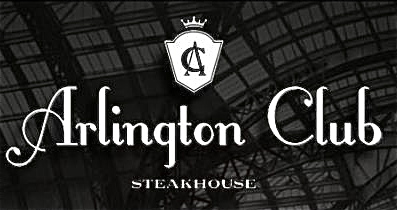
1032 Lexington Avenue (at 74th Street)
212-249-5700
arlingtonclubny.com
For reasons not difficult to discern in the NYC food media, restaurants on the Upper East Side get pounded more for their clientele than their food. Critics seem to love nothing more than to shower praise on cramped, inhospitable eateries in Red Hook and on the Lower East Side while raining down scorn on UES restaurants with a sure degree of posh and a guest list teeming with the kind of people for whom a $10 million condo is merely a pied-à-terre. So, what did Arlington Club expect when
 it tacked
"Club" onto its name, suggesting that it seeks
only a exclusive breed of affluents for whom steak
and a baked potato is more than enough choice and
where pricey Martinis are ordered by the round?
it tacked
"Club" onto its name, suggesting that it seeks
only a exclusive breed of affluents for whom steak
and a baked potato is more than enough choice and
where pricey Martinis are ordered by the round?Then, Arlington is owned by the people who run the monster Asian lounge/restaurant Tao in NYC and Vegas, so dropping several hundred dollars per person is almost de rigueur in such places. What the Tao Group did do in the kitchen was to install star chef Laurent Tourondel, formerly of the BLT steakhouse chain. Tourondel has a lot of cred in NYC, so the assumption was that he could draw more than the fleeting UES crowd it got right out of the chute. For the time being, that crowd is still jammed tight at the bar, well dressed, loud, and given to barking things like, "Well, hell, that's why you're such a good lawyer!' and "We're opening the Hamptons house early this year." This creates, of course, a pecking order that the front desk of lovely young women is hardly able to handle, so waits even for a reserved table can go on and on and on.
Still, when you sit down you will be well treated by a hospitable staff and begin to peruse a menu that is largely steakhouse fare with some sushi thrown in. Cordial hospitality has rarely been a hallmark of most NYC steakhouses, which play a much brasher form of favoritism than can be sensed at Arlington Club. We were first shown upstairs to the mezzanine, which is very beautiful and comfortable, then, when Tourondel spotted me, he insisted we have a big booth downstairs-- The noise, however, was fearful when we got there, already tamped down from Day One. Surprise, surprise! At the next booth were food writers from Vogue, New York Magazine, and the restaurant's meat supplier; across the room were the food critics from GQ and Time Out--talk about pressure on a chef and kitchen!
 And then there are
Tourondel's popovers (left): if any food item has ever
been perfected by man, these huge, puffed-up,
crispy, riddled with three kinds of cheese are
one. They are irresistible, wholly decadent,
and one is never enough. For a Frenchman who
probably never saw a popover till he got to NYC,
he has certainly trumped all others in this
Anglo-American classic.
And then there are
Tourondel's popovers (left): if any food item has ever
been perfected by man, these huge, puffed-up,
crispy, riddled with three kinds of cheese are
one. They are irresistible, wholly decadent,
and one is never enough. For a Frenchman who
probably never saw a popover till he got to NYC,
he has certainly trumped all others in this
Anglo-American classic.Steak and sushi is hardly a novel idea, but the surf-and-turf go well enough together. It's not the best sushi in town, but it's well done and abundantly proportioned. The yellowtail with jalapeno is particularly good. The beefsteak tomatoes--if in season--will make a good salad, lavished with Stilton cheese, and the jumbo crab cakes live up to their billing.
The roasted chicken is everything you could want in that ubiquitous
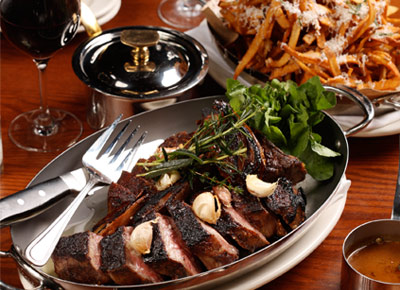 dish, accompanied by
good shoestring potatoes. Colorado
lamb chops are big, full-flavored and braised with
a parmesan crust, while the Dover sole is as fat
and sweet as that fish can possibly be, swimming
in butter with preserved lemon.
dish, accompanied by
good shoestring potatoes. Colorado
lamb chops are big, full-flavored and braised with
a parmesan crust, while the Dover sole is as fat
and sweet as that fish can possibly be, swimming
in butter with preserved lemon. When it comes to the beef, there’s no sense debating the provenance or aging, since Tourondel has never served any but the best. The steaks are slipped under a 1,200-degree broiler, allowed to rest, then quickly re-seared. Given the quality here, these steaks are certainly not out of line price-wise with competitors around town, though the 34 ounce côte de boeuf—a massive, beautiful cut—is up there at $130. The quirk is, it’s listed as serving two people, but believe me, three will easily be sated on this dish and you might even take some home. (For the record, the much-ballyhooed côte de bouef at Minetta Tavern is $140.)
What about apps and sides? They are sumptuous, from Gouda-rich mac-and-cheese to luscious truffled gnocchi (think butter, cream, cheese). The house fries have been perfected and they come out hot and stay that way, and the creamed spinach is excellent.
You won't need dessert but go ahead and order the crêpe soufflé for the table. Everyone will happy you did.
So, if you don’t wish to make the ride for a 3 PM reservation at Luger’s in Brooklyn or endure the embarrassment of being snubbed at Spark’s, Arlington Club is one of the best steakhouses in the city right now. And if the crowd somehow makes you antsy, sit upstairs and just enjoy yourselves.
Arlington Club is open for dinner nightly, for brunch Sat. & Sun. Appetizers $14-$26, main courses $26-$59.
NOTES FROM THE BREWERIES
Savvy public gets crafty about beer
 On
the first day of February, thousands of beer lovers
camped out on the
streets of downtown Santa Rosa, CA, waiting to plunk
down $4.50 for a 10-ounce pour of Pliny the Younger, a
triple IPA (India Pale Ale) available for only two
weeks each year. Some stood in line as long as six
hours to sample the coveted quaff from a pub operated
by Russian
River Brewing, producer of Pliny the Younger, Pliny
the Elder and a dozen other capriciously christened
beers. For three days this October, about
50,000 enthusiasts
will jam the Convention Center in Denver for the 32nd annual
Great American Beer Festival. The event,
which has sold out for the past five years, is
expected to attract 50,000 beer fans who will have
their choice of 2,000 offerings from some
500 breweries.
On
the first day of February, thousands of beer lovers
camped out on the
streets of downtown Santa Rosa, CA, waiting to plunk
down $4.50 for a 10-ounce pour of Pliny the Younger, a
triple IPA (India Pale Ale) available for only two
weeks each year. Some stood in line as long as six
hours to sample the coveted quaff from a pub operated
by Russian
River Brewing, producer of Pliny the Younger, Pliny
the Elder and a dozen other capriciously christened
beers. For three days this October, about
50,000 enthusiasts
will jam the Convention Center in Denver for the 32nd annual
Great American Beer Festival. The event,
which has sold out for the past five years, is
expected to attract 50,000 beer fans who will have
their choice of 2,000 offerings from some
500 breweries.
In
Virginia Beach recently, Green Flash Brewing of San Diego
announced it would build a $20 million dollar East
Coast plant, replicating its California facility. It is
one of several West coast breweries building plants along the
Atlantic to target the Eastern market, avoid heavy
shipping costs and
to facilitate exports to Europe. Dale’s Pale Ale of
Lyons, CO, now
has a facility in Brevard, . NC, New Belgium of Fort
Collins, CO, is coming to Asheville, and Sierra Nevada
of Chico, CA., will soon be in Mills River, NC.
Craft
beer, which has had its ups and downs since the
so-called beer revolution began half a century ago, is
on a roll. At its recent conference, the Brewers
Association proudly announced a 15% growth in volume
in 2012, against 1% for imported beers and no
gain for domestic non-craft beer. More than 400 craft
breweries opened in 2012, making a total of 2,347,
with 1,253 in the planning stage.
Anheuser-Busch, Coors and Miller , the big
boys of the business, while actually relinquishing only a
fraction of their enormous volume, have
recognized the revolution and fielded their own
craft beers. Miller-Coors is pushing Blue Moon
and Leinenkugel, while
Anheuser-Busch, papa of Budweiser, has launched
siblings Shock Top Belgian White, Hop Hound Amber
Wheat and Skipjack Amber, among others.
while
Anheuser-Busch, papa of Budweiser, has launched
siblings Shock Top Belgian White, Hop Hound Amber
Wheat and Skipjack Amber, among others.
And in
Manhattan on a recent March evening, the Irish pub Rattle N Hum (below) roiled
with an
overflow crowd thirsting for cask-drawn pours of Loose
Cannon and
a half dozen distinctive
brews from Clipper City Brewing of Baltimore,
MD. Owner-founder Hugh Sisson’s Loose Cannon
could be called
the East Coast equivalent of Pliny
the Younger. Its followers on that cold night
were just as
eager to be among the first to sample that
flagship beer in its 2013 New York debut as their
counterparts who pined for
Pliny on that warm day in Sonoma.
Hugh Sisson is the founder of Heavy Seas Beer, based
in Baltimore. As a college student he did not like
beer, and he had no plans for tarrying in his native
Baltimore where his father ran a tavern. In 1980, with
a master’s degree in theater, he was headed for NYC
but changed plans when his father urged him to stay
home and help out in
the family business. “I’d been back in
Baltimore for 20 minutes and I’m in the bar. My father
looks up, throws me the keys and as I catch them, he
says, `OK, don’t foul up,’ and he walks out the door.”
Taverns
in those
days “carried the same booze and the same beer, Bud,
Old Milwaukee and Pabst Blue Ribbon,” said Sisson. “We
didn’t have a kitchen and the only thing to focus on
was beer.” While
teaching himself accounting to bolster the bar’s
financial standing and learning marketing as he went,
he transformed
Sisson’s into the city’s busiest beer bar “simply
because that niche was available.” Within two years,
Sisson’s was posting
120 imported beers and was among the first
two bars in Maryland to offer Guinness on draft.
In
1984 he began home brewing. “It’s what you do, you’re
supposed to be knowledgeable,” he observes. Unlike
winemakers with advanced degrees in viticulture and
enology, most brewers today began as hobbyists.. Sam Adams,
a pioneer among craft beers, now almost a giant on its
own, began in
that same year, when Jim Koch toyed with a lager
recipe he found in his father’s attic. Sam
Calagione of the
very popular Dogfish Head Brewery in Delaware, started off
with a sour cherry ale
he created in a Manhattan kitchen. And in a practice
relatively uncommon among winemakers, craft
brewers work together, share recipes and facilities
and often produce joint ventures.
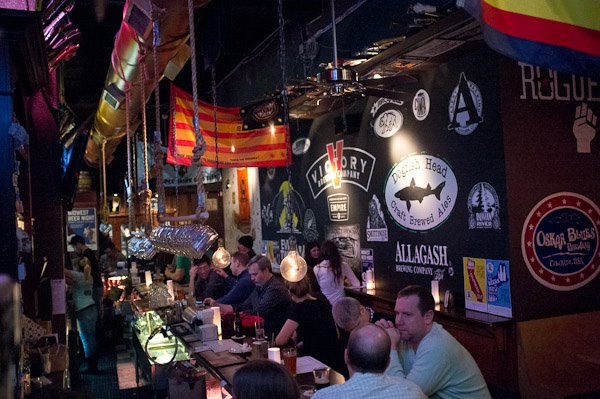 As a home
brewer, Sisson said,
“I was adequate at best. I’m not a terribly
patient person and making beer with kitchen utensils
was not very appealing to me.” He took giant steps in
the mid- and late eighties, buying professional gear,
transforming the bar into a brewpub and successfully
lobbying for the law
that legalized
brewpubs in Maryland. The beers he made then,
Sisson reminisced, would not have impressed today’s
more savvy consumers.
As a home
brewer, Sisson said,
“I was adequate at best. I’m not a terribly
patient person and making beer with kitchen utensils
was not very appealing to me.” He took giant steps in
the mid- and late eighties, buying professional gear,
transforming the bar into a brewpub and successfully
lobbying for the law
that legalized
brewpubs in Maryland. The beers he made then,
Sisson reminisced, would not have impressed today’s
more savvy consumers.
In 1995, he
launched Clipper City Brewing, later adopting today’s
more familiar name, Heavy Seas Beer. Over the years he
developed a pirate theme, with beers named Cutlass,
Powder Monkey, Peg Leg and his most popular offering,
Loose Cannon. He also is one of the leading advocates
of cask-conditioned real ale, special beers
transferred into special casks. In those casks, known as
firkins, they finish fermenting, naturally carbonating
(conditioning) and
are then dispensed
from those casks at participating outlets. Cask
conditioning, Sisson says, “yields a fresher beer, draft brew
at its finest.”
On the evening in Manhattan, Sisson poured his
flagship Loose Cannon, in three formats, as well as
Siren Noire, an imperial chocolate stout aged in
bourbon barrels;
Big Dipa, a double IPA aged on oak and topping
out at a high 10.5% alcohol; and Cutlass Amber Lager,
slightly sweet from a combination of crystal, Vienna
and Munich malt. Cutlass is the firm’s second best
seller and its most award winning brew. I also
sampled Below Decks Barleywine, a unique beer, aged
in cabernet barrels and Plank II Dopplebock, which
uses toasted eucalyptus and poplar to import tangy
vegetal notes.
Unlike winemakers who must wait
years to see what their vineyard produces, craft
brewer can have a fantasy and realize
those ideas almost overnight. Most do, and they never
seem to
run out of odd names.

AND WHICH ONES HAVE VOTED TO DECREASE FOOD STAMPS
FUNDS?
According to a review of Congressional spending, many of
our elected officials are living quite high on the hog
of taxpayers’ money. House
Majority Whip Kevin McCarthy spent nearly $10,000 on
food and beverage during the last quarter of 2012 and more than
$2,500 at a Tex-Mex restaurant on one day alone. House Speaker
John Boehner spent even more: $11,225 in
food-and-beverage expenses, including $2,000 on coffee
alone. House Majority Leader Eric Cantor blew $3,000.
House Minority Leader Nancy Pelosi’s food bill was
$3,510 and Minority Whip Steny Hoyer’s was $1,795.
FOOD WRITING 101: DO
NOT USE PIRATE PROSE WHEN QUOTING CHEFS
"Eric
Chavot is the genuine article. He kisses
ladies' hands like it's not an absurd thing to do. He
rolls his eyes and babbles in an accent so thick it
piles up in drifts around the chair legs. Mind you,
Chavot has been doing this in the capital for years.
I've long fantasised that it's a put-on job. Behind the
kitchen door he probably speaks like Ray
Winstone in a bad east London gangland
thriller. `Awright then, let's be 'avin' that farkin'
gigot and don't be givin' me none of your lip…' "--Jay
Rayner. "Brasserie Chavot: restaurant review," The London Observer
(March 2013).
Any of John Mariani's
books below may be ordered from amazon.com.
 |
My latest book, which just won the prize for best book from International Gourmand, written with Jim Heimann and Steven Heller, Menu Design in America, 1850-1985 (Taschen Books), has just appeared, with nearly 1,000 beautiful, historic, hilarious, sometimes shocking menus dating back to before the Civil War and going through the Gilded Age, the Jazz Age, the Depression, the nightclub era of the 1930s and 1940s, the Space Age era, and the age when menus were a form of advertising in innovative explosions of color and modern design. The book is a chronicle of changing tastes and mores and says as much about America as about its food and drink.
“Luxuriating vicariously in the pleasures of this book. . . you can’t help but become hungry. . .for the food of course, but also for something more: the bygone days of our country’s splendidly rich and complex past. Epicureans of both good food and artful design will do well to make it their coffee table’s main course.”—Chip Kidd, Wall Street Journal.
“[The menus] reflect the amazing craftsmanship that many restaurants applied to their bills of fare, and suggest that today’s restaurateurs could learn a lot from their predecessors.”—Rebecca Marx, The Village Voice. |
"Eating Italian will never be the same after reading John Mariani's entertaining and savory gastronomical history of the cuisine of Italy and how it won over appetites worldwide. . . . This book is such a tasteful narrative that it will literally make you hungry for Italian food and arouse your appetite for gastronomical history."--Don Oldenburg, USA Today. "Italian
restaurants--some good, some glitzy--far
outnumber their French rivals. Many of
these establishments are zestfully described
in How Italian Food Conquered the World, an
entertaining and fact-filled chronicle by
food-and-wine correspondent John F.
Mariani."--Aram Bakshian Jr., Wall Street
Journal.
"Equal parts
history, sociology, gastronomy, and just
plain fun, How Italian Food Conquered the
World tells the captivating and delicious
story of the (let's face it) everybody's
favorite cuisine with clarity, verve and
more than one surprise."--Colman Andrews,
editorial director of The Daily
Meal.com. "A fantastic and fascinating
read, covering everything from the influence
of Venice's spice trade to the impact of
Italian immigrants in America and the
evolution of alta cucina. This book will
serve as a terrific resource to anyone
interested in the real story of Italian
food."--Mary Ann Esposito, host of PBS-TV's
Ciao
Italia. "John Mariani has written the
definitive history of how Italians won their
way into our hearts, minds, and
stomachs. It's a story of pleasure over
pomp and taste over technique."--Danny Meyer,
owner of NYC restaurants Union Square Cafe,
Gotham Bar & Grill, The Modern, and
Maialino.
|
 |
 |
 |
 |
 |
 |
 |
 |
 Everett Potter's Travel Report:
Everett Potter's Travel Report: 
 Eating Las Vegas
is the new on-line site for Virtual Gourmet
contributor John A. Curtas., who since 1995
has been commenting on the Las Vegas food
scene and reviewing restaurants for Nevada
Public Radio. He is also the
restaurant critic for KLAS TV, Channel 8 in
Las Vegas, and his past reviews can be
accessed at KNPR.org.
Click on the logo below to go directly to
his site.
Eating Las Vegas
is the new on-line site for Virtual Gourmet
contributor John A. Curtas., who since 1995
has been commenting on the Las Vegas food
scene and reviewing restaurants for Nevada
Public Radio. He is also the
restaurant critic for KLAS TV, Channel 8 in
Las Vegas, and his past reviews can be
accessed at KNPR.org.
Click on the logo below to go directly to
his site.

Tennis Resorts Online: A Critical Guide to the World's Best Tennis Resorts and Tennis Camps, published by ROGER COX, who has spent more than two decades writing about tennis travel, including a 17-year stretch for Tennis magazine. He has also written for Arthur Frommer's Budget Travel, New York Magazine, Travel & Leisure, Esquire, Money, USTA Magazine, Men's Journal, and The Robb Report. He has authored two books-The World's Best Tennis Vacations (Stephen Greene Press/Viking Penguin, 1990) and The Best Places to Stay in the Rockies (Houghton Mifflin, 1992 & 1994), and the Melbourne (Australia) chapter to the Wall Street Journal Business Guide to Cities of the Pacific Rim (Fodor's Travel Guides, 1991).


MARIANI'S VIRTUAL GOURMET
NEWSLETTER is published weekly. Editor/Publisher: John
Mariani.
Contributing Writers: Christopher Mariani, Robert Mariani,
John A. Curtas, Edward Brivio, Mort Hochstein,
Suzanne Wright, and Brian Freedman. Contributing
Photographers: Galina Stepanoff-Dargery,
Bobby Pirillo. Technical Advisor: Gerry McLoughlin.
© copyright John Mariani 2013
